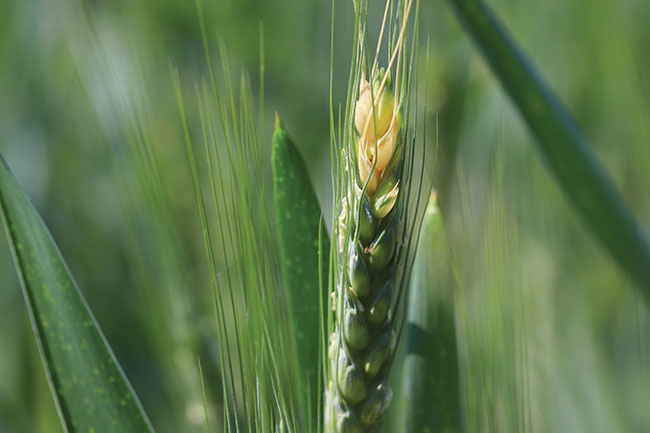
Features
Fungicides
Biocontrol agents show promise against fungal diseases
Non-chemical control option could help control disease in field crops.
March 14, 2023 By Julienne Isaacs
 Myriam Fernandez, head of the Organic Research Program at Agriculture and Agri-Food Canada’s Swift Current Research and Development Centre, is the author of new research pointing to a non-chemical control option for devastating diseases of field crops, including fusarium head blight.
Photo Aleksa/Adobe stock.
Myriam Fernandez, head of the Organic Research Program at Agriculture and Agri-Food Canada’s Swift Current Research and Development Centre, is the author of new research pointing to a non-chemical control option for devastating diseases of field crops, including fusarium head blight.
Photo Aleksa/Adobe stock. Control of fungal diseases in cereal and pulse crops across Western Canada has traditionally relied on a combination of strategies including resistant varieties, rotation and chemical controls.
But the latter are not always effective or available, and alternative management options are needed, particularly in organic systems, says Myriam Fernandez, head of the Organic Research Program at Agriculture and Agri-Food Canada’s Swift Current Research and Development Centre.
Fernandez is the author of new research pointing to an exciting non-chemical control option for devastating diseases of field crops, including fusarium root rot, fusarium head blight, common root rot, black point and spot blotch.
Biocontrol fungi, says Fernandez, have been shown to control diseases and pests in some crops. They’re also beneficial organisms that in some cases can offer additional benefits to their plant hosts.
“Some of these, such as Clonostachys species, are known endophytes – fungal or bacterial organisms that live in plants for at least part of their life cycle – able to promote plant growth and drought tolerance,” she noted in a presentation last year.
These fungal biocontrol agents are more abundant in organic versus conventional systems, due to the use of chemical inputs in the latter. “Identifying and isolating potential biocontrol organisms can occur foremost in organic systems, not in systems where synthetic chemical application might affect their survival and/or reproduction,” says Fernandez.
Experiments
In a recent publication, Fernandez and collaborators Lobna Abdellatif and Prabhath Lokuruge outline the mode of action of three promising biocontrol agents–Clonostachys miodochialis, C. rosea, and Minimedusa polyspora.
The three beneficial fungi were selected for study after preliminary testing demonstrated their ability to inhibit the growth of target fungi, including the Fusarium species F. acuminatum, F. avenaceum, F. equiseti and F. graminearum, and Cochliobolus sativus, the causal agent of common root rot and other cereal diseases.
Fernandez and her collaborators tested the biocontrol agents’ ability to control target fungi in culture dishes in the lab.
“The [biocontrol agents] were able to inhibit the mycelial growth of most of the target fungi, with the most common mode of action being mycoparasitism,” the researchers write.
The type of parasitic relationship established by the biocontrol agents examined depended on the target fungus.
Fernandez says the biocontrol agents’ ability to suppress target fungi justified further trials.
“In further greenhouse and field trials, these endophytes also led to the improvement of crop growth,” she says. “The field testing has been limited due to drought conditions in the last few years, but so far we have seen an ability to increase crop growth.”
Field applications
Fernandez’ lab is focused on helping producers determine how to naturally increase the presence of some of these species in the field, versus commercializing a new product which would result in an additional input cost to producers. The latter process can also be very difficult in Canada. For example, a C. rosea biopesticide was developed by AAFC’s Alan Xue in the 1990s, but at the time of writing had not been commercialized.
The importance of non-chemical control agents goes beyond organic systems. More and more producers, Fernandez notes, are increasingly interested in alternative disease control methods, due in part to the cost of chemical inputs and the spread of resistance to them. “The impact of practices involving intensive chemical use also includes the rejection of some agricultural products in international markets due to residue limits.”
“The increased popularity of biopesticides, and current trend in that direction, could be attributed to consumer demand for a reduction in intensive chemical use, concern for food safety and pesticide residues, water pollution [and] impacts on biodiversity,” she adds.
Biocontrol control options, or “biologicals,” are positioned to eventually replace some chemical inputs, she says.
One way to naturally boost the presence of biological control agents in the field, she writes, is by choosing the right cropping sequence and/or intercropping combinations. Mustard, for example, can boost beneficial fungi in the field in addition to having allelopathic properties.
But this work is ongoing.
“We aim to identify and establish optimal crop sequence, and cropping system, strategies to encourage the populations of these organisms for the control of important diseases and improved crop productivity, nutrient use efficiency, and profitability, while also making sure that no aspect of those systems would result in a negative outcome in regards to soil nutrients and/or crop growth,” says Fernandez.
We gratefully acknowledge funding by Prairie Heritage Seeds Organics Inc., Saskatchewan Wheat Commission, Alberta Wheat Commission, and the Agri Science Program under
Agriculture and Agri-Food Canada’s Canadian Agricultural Partnership, through the Organic Science Cluster 3, led by the Organic Federation of Canada in collaboration with the Organic Agriculture Centre of Canada.